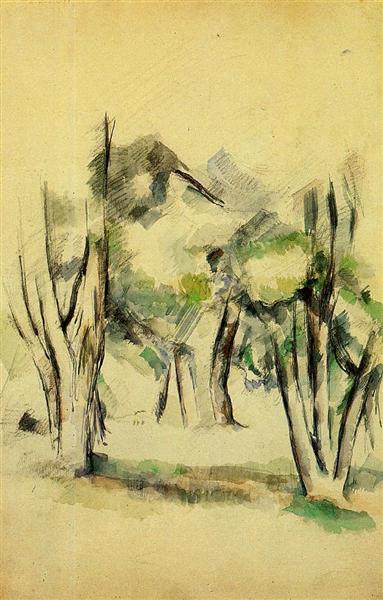Opis
Paul Cézanne's Trees (1884) stands as a fascinating example of Post-Impressionism, a style that Cézanne helped define and that paved the way for modernity in art. This painting stands out for its energetic composition and distinctive exploration of form and color, elements that are fundamental to understanding the artist's innovative approach.
In “Trees,” Cézanne captures a natural scene dominated by the lushness of trees. The painting evokes a sense of depth and density, thanks to the way Cézanne applies his brushstrokes. His unique technique involves the use of short, homogeneous strokes that bring to life an almost monumental structure of vegetation, which contrasts with the fluidity of the landscape. This particular way of working the surface not only reflects reality, but also conveys a sense of movement and vitality.
Colour is another central aspect of the work. Cézanne uses a vibrant and carefully selected palette. Greens, which vary in intensity, mix with earthy tones, creating shadows that suggest volume and texture. The nuances of blue and grey that can be seen in certain places provide an atmosphere of serenity and invite the viewer to immerse themselves in the scene. This use of colour moves away from strict realism, coming closer to emotional representation than to a simple recording of nature.
It is interesting to note that Trees fits into a broader context of Cézanne's work, where trees and vegetation provide rich ground for his investigation of form and structure. Cézanne's earlier works already featured an interest in nature, but during the 1880s in particular his work moved towards a greater simplification and geometrization of elements, evident in his treatment of the treetops, which appear almost cubic in their representation. This approach prefigures the explorations of Cubism, a break with traditional representations that Cézanne inspired in later generations of artists.
Unlike many works depicting landscapes, “Trees” does not include human figures, which further draws attention to the natural surroundings. This absence of characters becomes a powerful statement of the relationship between humans and nature, suggesting a deeper connection to the landscape presented in the painting. By removing the human figure, Cézanne focuses the visual narrative on the essence of the trees themselves and their inherent majesty, suggesting that they are, in and of themselves, protagonists of the work.
Ultimately, Cézanne's "Trees" is a splendid testament to the artist's ability to fuse meticulous observation and innovative aesthetic conception. In this canvas, the figure of trees not only serves as an object of the natural world, but also becomes, in Cézanne's hands, an exploration of perception, color, and form that continues to resonate in art to this day. Its legacy endures, not only for its contribution to the movements that followed it, but also for the way it pushes viewers to reconsider the way they relate to the environment around them.
KUADROS ©, a famous painting on your wall.
Hand-made oil painting reproductions, with the quality of professional artists and the distinctive seal of KUADROS ©.
Painting reproduction service with satisfaction guarantee. If you are not completely satisfied with the replica of your painting, we will refund 100% of your money.

